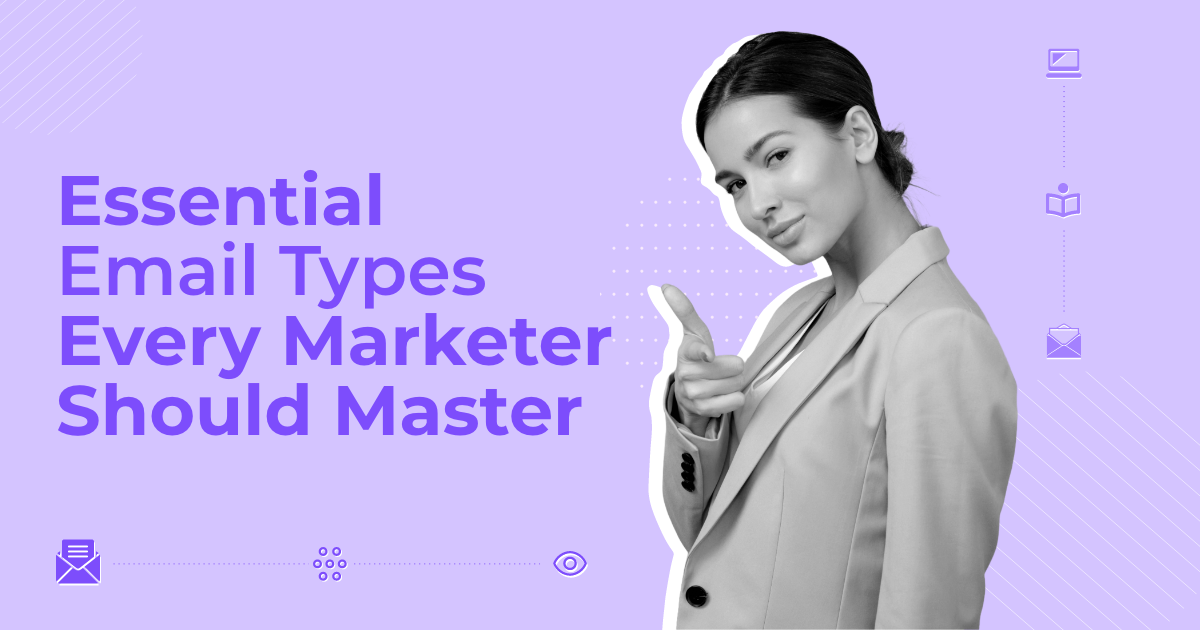
Email Copywriting: The Complete Guide For Beginners [2025]
Struggling to craft effective email copy that truly resonates with your audience?
Many marketers face the same challenge with their email copywriting, often making it too impersonal or relying on AI assistants for a quick fix. While these tools can be helpful, the results often lack the personal touch and strategic finesse needed to drive real engagement and conversions.
Whether you’re a seasoned marketer who hasn’t quite mastered the art of copywriting, a beginner eager to learn, or someone looking to enrich their skills, this guide will cover everything you need to learn to make your copy valuable.
In this guide, you’ll learn about the key components of an effective email, see examples from popular brands, and discover practical tips for crafting compelling content.
What is Email Copywriting?
Copywriting for email marketing involves crafting all the textual elements within an email to convert prospects and achieve your marketing goals.
This includes everything from the subject line and body copy to the call-to-action (CTA) and footer. Effective email copywriting requires specific techniques to engage readers, address their pain points, and prompt them to take the desired action
Email Copywriting vs Content Marketing
Copywriting for email and content marketing are both essential components of a digital marketing strategy, but they have different purposes and approaches.
Email copywriting focuses on crafting compelling email content aimed at capturing the recipient’s attention and prompting immediate actions, such as clicks, sign-ups, or purchases.
On the other hand, content marketing encompasses a broader range of content types, such as blog posts, videos, and social media updates, with the goal of attracting and engaging a wider audience over the long term.
Why is Email Copywriting Important?
Did you know that email is one of the most profitable marketing channels, offering an incredible ROI of $42 for every $1 spent? The secret behind this profitability is great email copy, which helps build relationships and drive sales.
Well-written messages can significantly impact open rates, click-through rates, and conversions. Apart from that there a few more benefits you should be aware of:
- It gently guides prospects toward taking the desired action without being forceful.
- Encourages prospects to spend more time reading and interacting with the content.
- Boosts the likelihood of your brand being remembered.
- Helps achieve marketing strategy goals, making your brand more profitable.
- Improves conversion rates and drive sales.
A good email copywriter’s job is to create captivating content for the brand’s audience.
To do that, they need to set clear objectives. This way, they can enhance the effectiveness of email marketing campaigns, leading to better email engagement, higher conversions, and overall marketing success.
Key characteristics of copywriting for email marketing
Crafting effective email copy is essential for achieving your marketing goals. To make it work, tt requires a balance of persuasion, clarity, and engagement to lead your target audience to action.
Here are the key characteristics that define successful email copywriting:
- Conciseness: It needs to be highly persuasive in as few words as possible, avoiding fluff content.
- Consistency: There must be a clear connection between the subject line, body copy, and CTA.
- Interactivity: Excellent copy should engage the reader, prompting actions like clicking a link or sharing content.
- SEO principles: Applying SEO copywriting principles can help your email stand out.
Email copywriting is challenging and requires excellent writing skills, creativity, and attention to detail. However, with the right approach, it can be an engaging and rewarding task.
Copywriting for Email Marketing: Industry Use Cases
Email copy isn’t bound by any specific industry. Everyone can use it to achieve different goals, such as educating their audience or prompting them to make a purchase.
Here are some of the best industry use cases to get an idea of how useful email copy can be:
- Ecommerce: Promotes products, offers discounts, and sends order confirmations and shipping updates.
- Technology and SaaS: Onboards new users, provides product updates, and educates customers through email newsletters.
- Finance and banking: Delivers important account information, offers financial advice, and promotes new financial products.
- Healthcare: Sends appointment reminders, health tips, and promotional content for new services.
- Education: Provides information about courses, events, and student resources.
- Real estate: Shares new property listings, market updates, and open house invitations.
- Travel and hospitality: Promotes travel deals, sends booking confirmations, and offers travel tips.
- Nonprofits: Communicates with donors, shares success stories, and promotes fundraising events.
- Retail: Announces sales, new product launches, and seasonal promotions.
Now that you know the benefits and use cases, let’s examine the available email formats you can use.
Email Campaign Formats
Did you know that your campaign format greatly influences the way you write your email copy?
When crafting email sequences, you can choose between plain-text and HTML formats. Each one has its own unique advantages and disadvantages, which can affect the performance of your message.
Below are the two main formats that businesses use.
Plain-Text Emails
Plain-text emails contain only text without any formatting, images, or embedded links, resembling a standard email you might send from your personal email account.
Here’s a great example from John’s Crazy Socks:

- Pros: These messages are simple, quick to load, and have a personal, conversational tone that can feel more genuine to the recipient. They’re mostly used for outreach and business follow-ups.
- Cons: The lack of visual elements may result in lower engagement rates, making them appear less professional or appealing compared to HTML emails.
HTML Emails
HTML messages use HTML and CSS to create visually appealing emails with images, links, buttons, and various formatting options.
Here’s an example from Beige Brown:
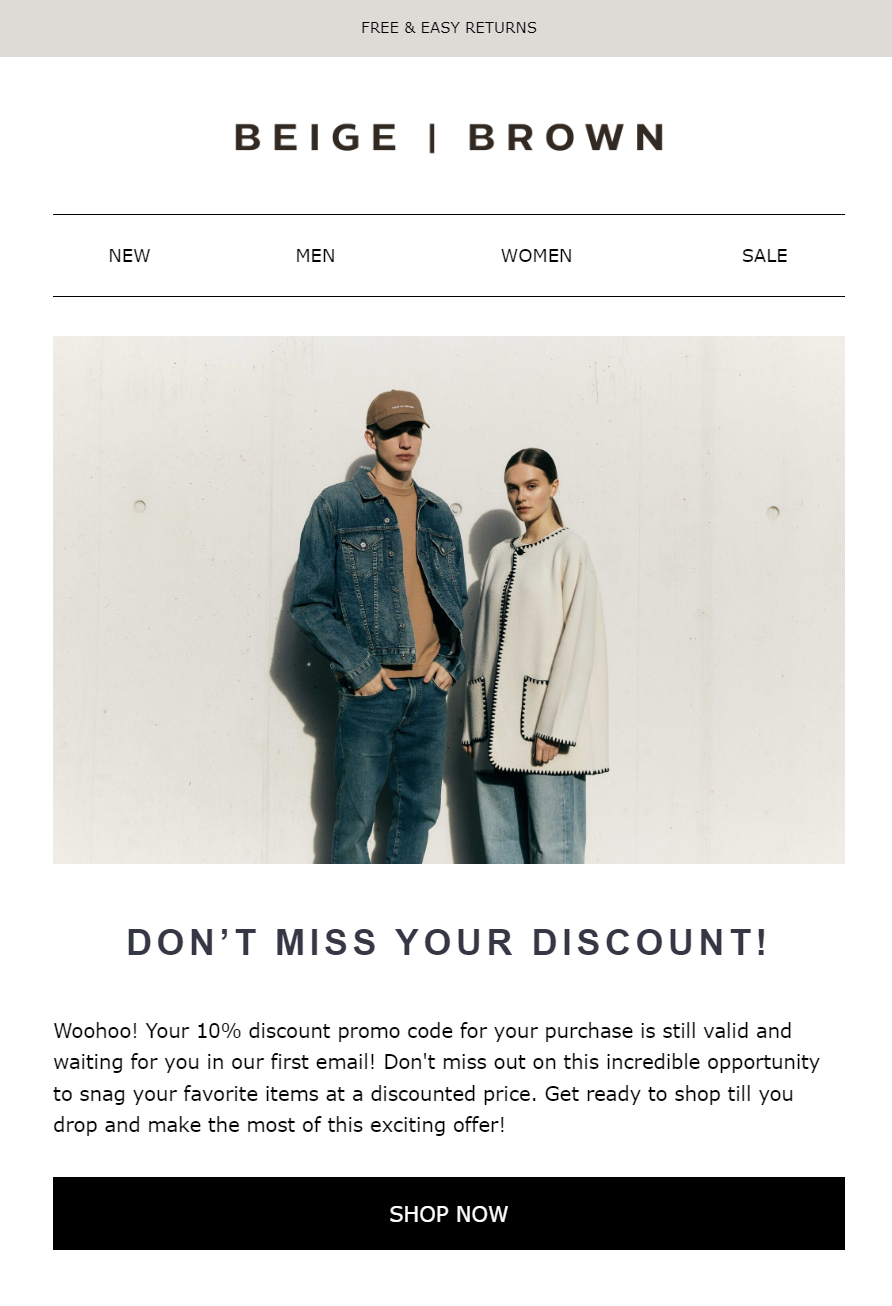
- Pros: These emails can be more engaging, offering a better visual experience with the ability to incorporate branding, graphics, and interactive elements, such as GIFS.
- Cons: They can be more complex to design and may take longer to load, with a risk of rendering issues on different email clients.
To avoid any issues with HTML email creation, you can choose a reliable email marketing platform that offers a good HTML builder, with drag-and-drop functionality and inbox testing features.
Moosend, for example, has a user-friendly interface to create stunning emails without the hassle. Then, you can use the preview tool to spot rendering errors and mistakes before sending.
Build the right email for your audience
Or save time with Moosend’s ready-made templates.
Try for freeHow does email format impact email copy?
Understanding the differences between plain-text and HTML emails can help you choose the right email copy.
Here’s how each format affects your email copywriting strategy and how to approach it:
Plain-Text emails:
- Should be conversational and personal to maintain a genuine feel.
- Focus on clear, concise messaging without relying on visual aids.
- Use short paragraphs and bullet points to make the text easy to read.
HTML emails:
- Can vary in tone from professional to casual, depending on the brand image.
- Allows for richer content with the use of images, buttons, and formatted text.
- Can be more visually complex, with sections, headers, and various design elements to guide the reader.
Email Campaign Components
In the previous section we saw the campaign formats you can choose. Now, let’s see the components you need to focus on.
First off, emails are made up of various elements, divided into textual and visual.

The visuals include everything from your header to product images or GIFs, which play a crucial role in capturing attention and enhancing the message. You can find more in our newsletter images guide.
Now, the textual part includes the subject line, preview and preheader text, email body, and CTA. These will convince your email subscriber to act.
Understanding these components will give you more clarity when crafting your email content. Let’s take explore each one in mor detail.
Email subject line
Your subject lines are the first thing recipients see when they open their inbox. To attract attention, they should be concise, engaging, and relevant.
Now let’s look at our Gmail inbox below:

The above subject lines are concise, with most being around 5-10 words.
Ideally, your creations need to be between 36-70 characters and that based on the type of device your subscribers use. Remember, mobile devices show a limited number of characters compared to desktop.
Let’s see what else works here:
- Language: The language is engaging and action-oriented, often including phrases that create a sense of urgency or exclusivity (e.g., “Hurry Up!”, “LAST DAY”, “24hrs left”).
- Personalization: One of the subject lines includes the recipient’s name or directly address the reader, e.g., “Marilia, here’s the scoop.”
- Offers and deals: They highlight special offers, discounts, or promotions.
- Emojis: Two subject lines use emojis to attract attention and add a visual element, e.g., “👀” and “💕”
- Friendly tone: The tone is generally informal and friendly, aiming to create a connection with the reader.
By looking at your inbox you can easily see what your competitors are doing.
Then, take a moment to analyze their subject lines and create yours following some subject line best practices, which we’ll see later on.
Preview & Preheader Text
Your preview text follows the subject line, offering additional context or a teaser to encourage the recipient to open the email.
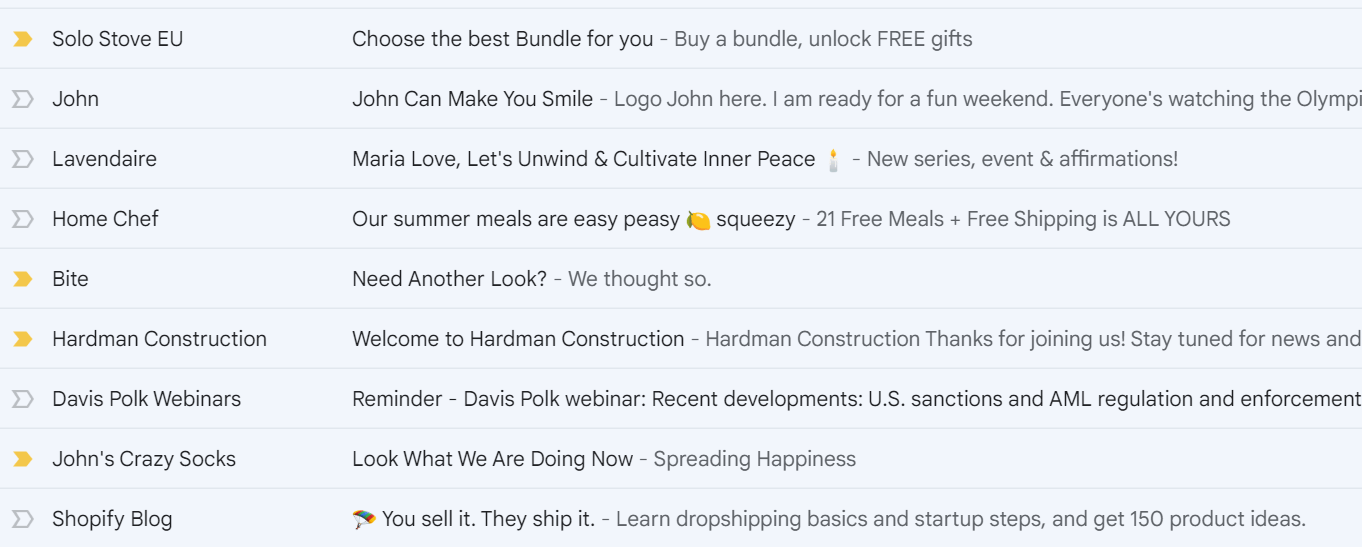
- Length: They need to be short and concise, ideally just a few words to a sentence.
- Extra incentives: Emphasize any special offers, discounts, or free items to add value to the subject line, e.g., “Buy a bundle, unlock FREE gifts.”
- Specific details: Provide additional details about the email content to build interest and set clear expectations.
- Value proposition: Offer a strong value proposition that reinforces the subject line, e.g., “21 Free Meals + Free Shipping is ALL YOURS.”
- CTA: Ensure the preview text includes or supports a clear call to action, encouraging the reader to open the email.
It’s good to know that your preview text differs from the preheader text, which is a short summary that appears at the top of your email before the header.

Without a preview text, the email client may pull in the first few lines of your email content, which might not be as compelling or relevant, potentially decreasing the chances of your email being opened.
Email Body
The email body is the main content area where you convey your message to the recipient. It includes two parts: the greeting and main content.
Let’s see them in the following welcome email example:
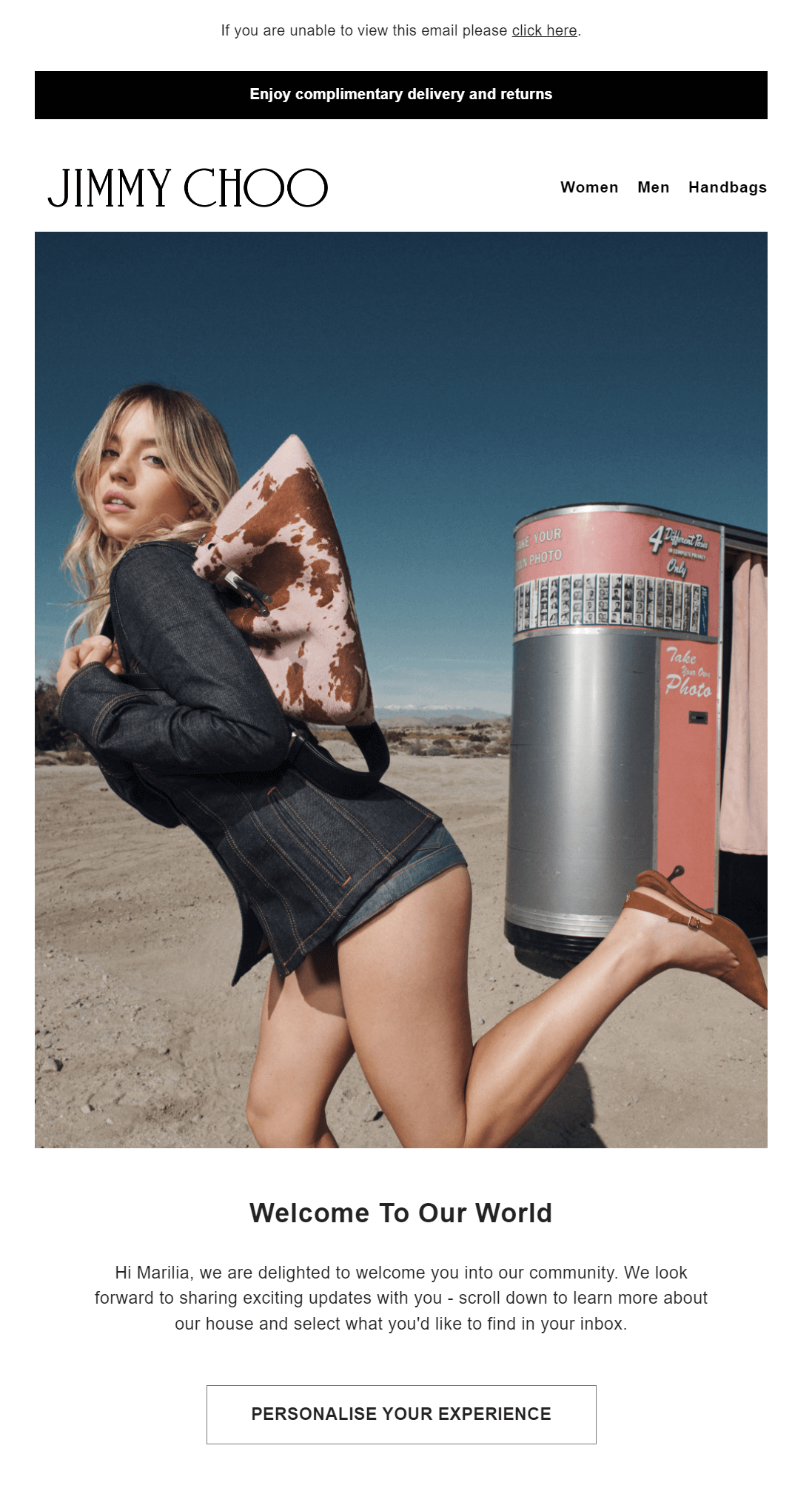
Greeting
- Copy: “Hi Marilia, we are delighted to welcome you into our community.”
- A personalized greeting will create a connection with the recipient and make them feel valued. Using the recipient’s name is a simple yet effective way to do that.
Main content
- Copy: “We look forward to sharing exciting updates with you – scroll down to learn more about our house and select what you’d like to find in your inbox.”
- The core message of your email should provide relevant information that interests the reader. It should be concise and engaging, offering a clear value proposition or update.
Call-to-action (CTA)
A CTA directly encourages the recipient to take the next step, whether it’s making a purchase, signing up, or personalizing their experience.
The lack of a compelling button will lead to missed opportunities for interaction and conversion.
CTAs need to be relevant to the email content and provide value to the reader, aligning with the email’s main message and goals.
Here’s an example from American Giant, choosing a red CTA button in their email to attract attention:
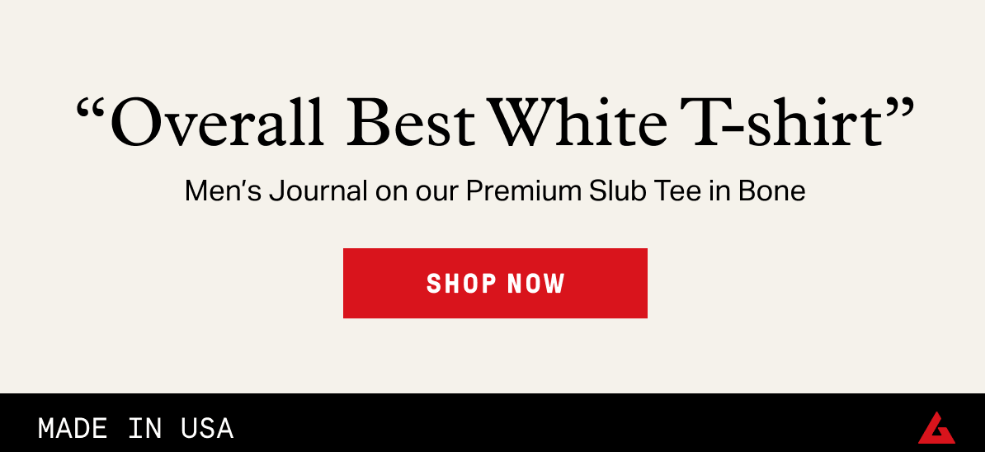
Footer
An email footer is the section at the bottom of an email that typically includes important information.
It serves as a final touchpoint with your reader, providing essential information and reinforcing your brand’s credibility.
Copy-wise, email footers don’t require much. However, you can use them to:
- Feature your company’s contact details, such as address, phone number, and email address, to make it easy for recipients to get in touch.
- Add privacy policies or terms of service, to ensure compliance.
- Provide a clear and easy-to-find unsubscribe link to comply with email regulations and give recipients control over their subscriptions.
- Reinforce your brand by including your logo, tagline, or a brief brand message.
- Add links to your social media profiles to encourage further engagement and connect with your audience on multiple platforms.
- Remind them why they keep receiving your newsletter.
Here’s a very on-brand email footer that reflects Chubbies’ brand voice:
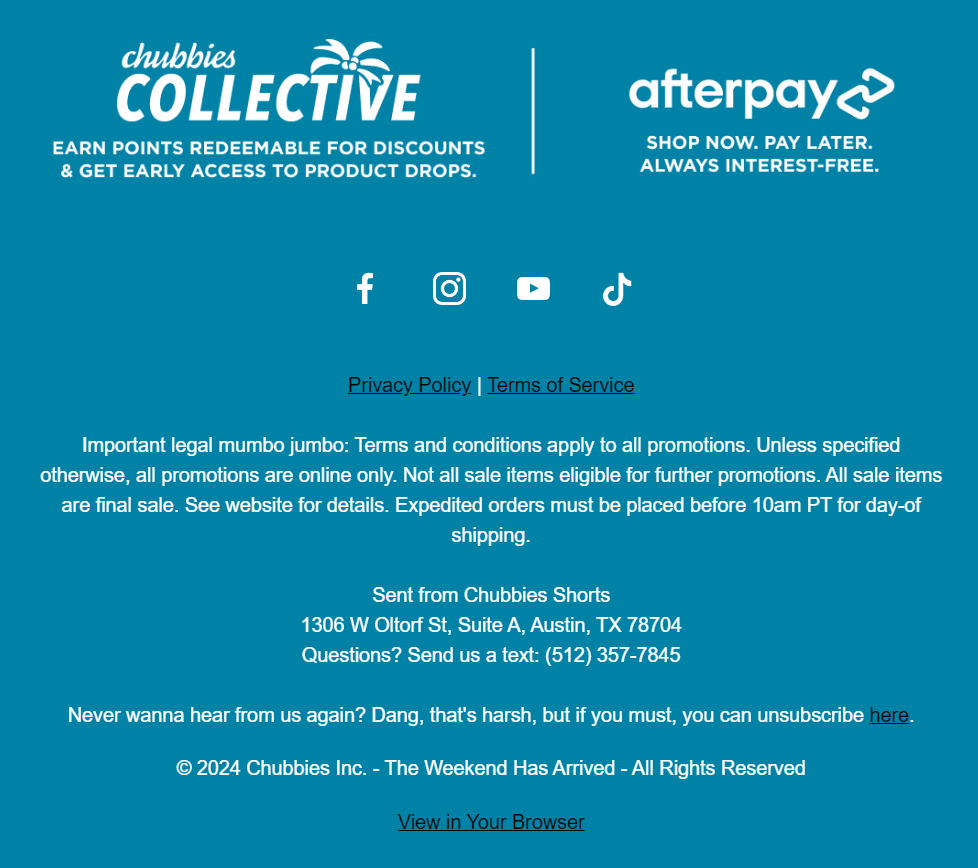
Now that we’ve covered the basic components of an email, let’s see some actionable tips you should implement every single time.
How to Write Good Email Body Copy
In this section, we’ll provide actionable tips on how to create compelling copy for your campaigns, from personalizing your message to using social proof.
Also, we’ve added several email copy examples to see how other business owners have structured their content marketing strategy.
1. Use personalization
Email personalization involves tailoring your emails to individual recipients based on their preferences, behaviors, and personal information.
This approach helps make your emails more relevant and engaging, increasing the likelihood of interaction and conversion.
To implement personalization, you need to collect customer insights through lead magnets, newsletter signup forms, surveys, and user interactions on your website.
Then, use an email marketing tool that supports personalization features to automate the process of inserting personalized content into your emails based on the collected data.
Here are some easy ways to use personalization in your email copy:
- Add your recipient’s name to your email body copy for a personal touch.
- Take advantage of their preferences or past behavior to tailor content, e.g., highlight different products based on past browsing/purchases.
- Divide your email list into segments based on demographics or purchase history.
- Incorporate dynamic content blocks that change based on the recipient’s data, e.g., location.
Now, let’s see an example:
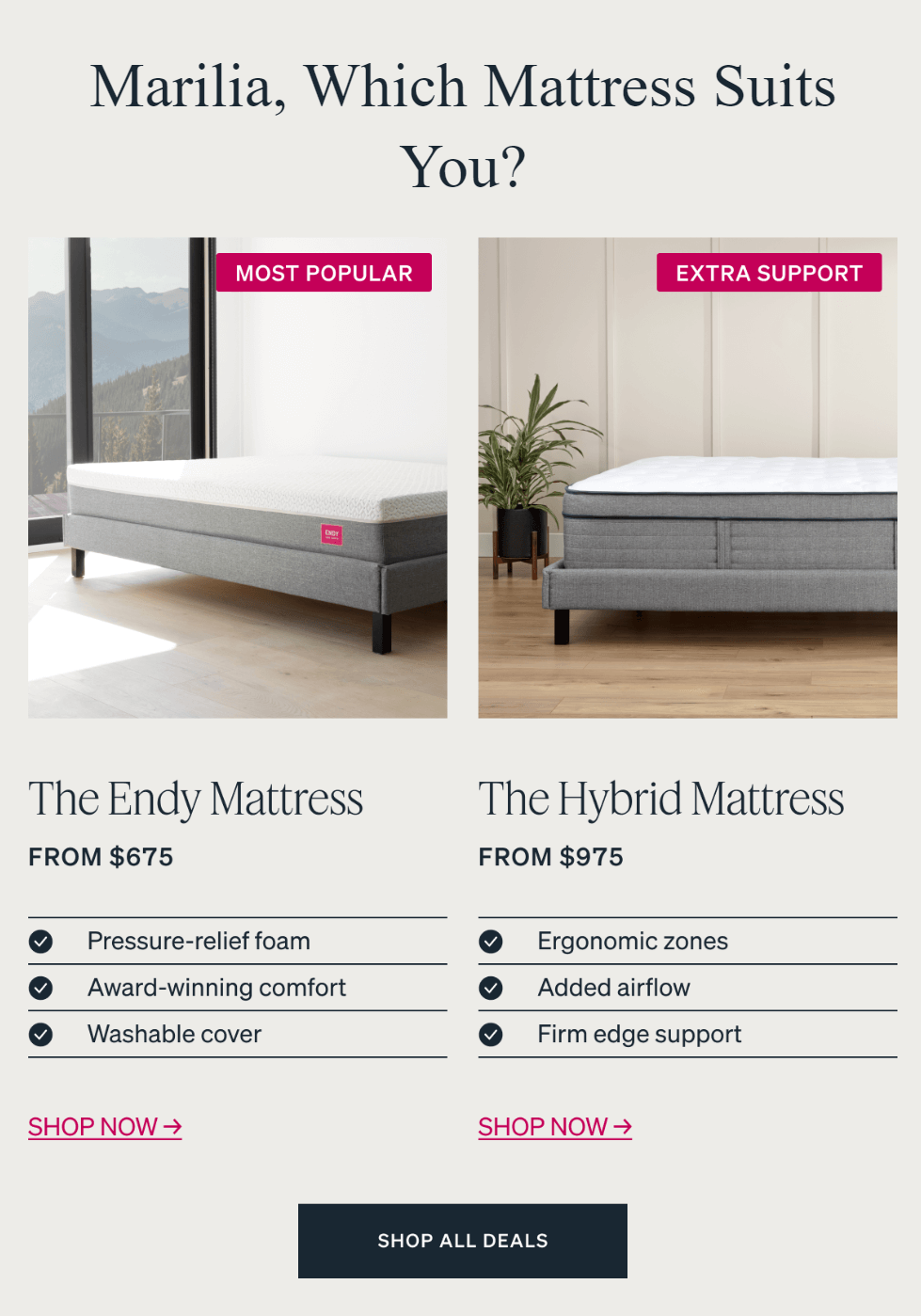
Here’s what makes Endy’s email work:
- It has a personalized greeting, “Marilia, Which Mattress Suits You?”
- It showcases two mattress options, each with specific features highlighted to help the recipient make an informed decision.
- Each option includes key benefits and a clear call to action, making it easy to proceed to the next step.
If you’re interested in using personalization, you can try Moosend’s smart automation and personalization features. The platform also has online forms and segmentation tools to capture your visitors’ details and segment your email list before you start personalizing your email copy.
2. Use engaging language
When writing email copy, you need a friendly tone to keep the reader interested. This will make your email feel more personal and less like a mass message.
Also, you should avoid long paragraphs and unnecessary jargon to maintain the reader’s attention and ensure high readability.
For better results, add strong action words that prompt the reader to act, creating urgency and excitement around your message. Don’t forget to use proper language that is appropriate for your audience, avoiding offensive terms and trying to be as inclusive as possible.
Lastly, you should tailor your email copywriting to the specific audience you are targeting, adjusting your tone and style accordingly, such as writing differently for Boomers compared to Gen Z.
Here’s how Prime, a hydration drink brand, does it:
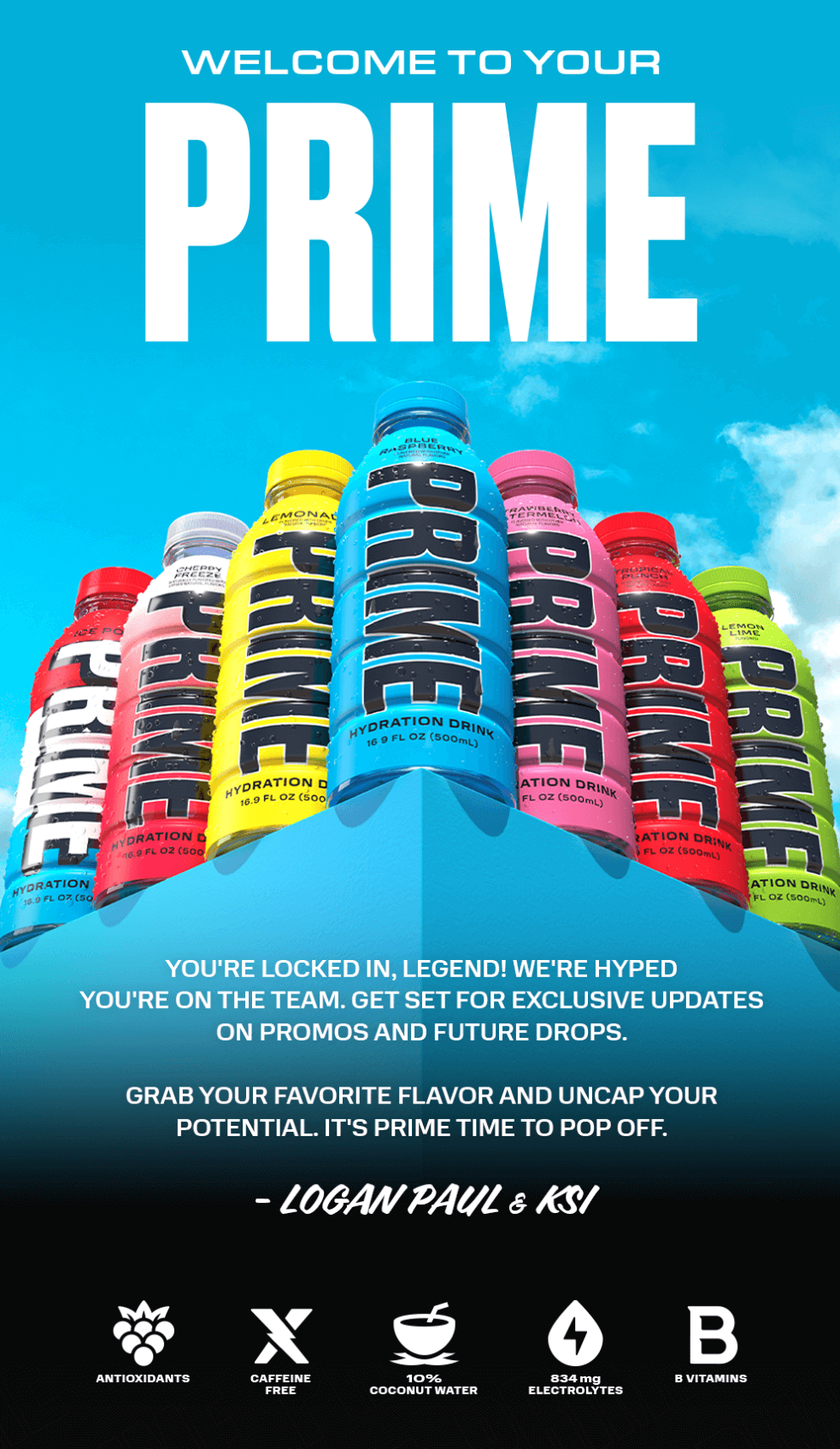
Here, the language is energetic and motivational, using terms like “You’re locked in, legend!” and “Get set for exclusive updates.” This conversational tone resonates well with the targeted demographic, creating a sense of excitement and community.
Prime’s email campaign is a perfect example of how the product influences the campaign strategy. It uses vibrant colors, dynamic language, and a motivational tone to appeal to the customer.
This approach would differ if the product were aimed at an older audience, where a more formal tone and different email design elements might be more effective.
3. Address customer pain points
To make your email content more relevant and engaging, you need to create detailed customer personas to target your audience more effectively.
Understanding these personas will let you address their unique needs and preferences, instead of spamming them with generic offers.
With your personas ready, you can acknowledge their pain points and tell them how your product can help them. One valuable piece of advice here is to always use honest language and avoid overpromising to prevent underdelivering.
Now, let’s analyze an example from Tommie Copper:
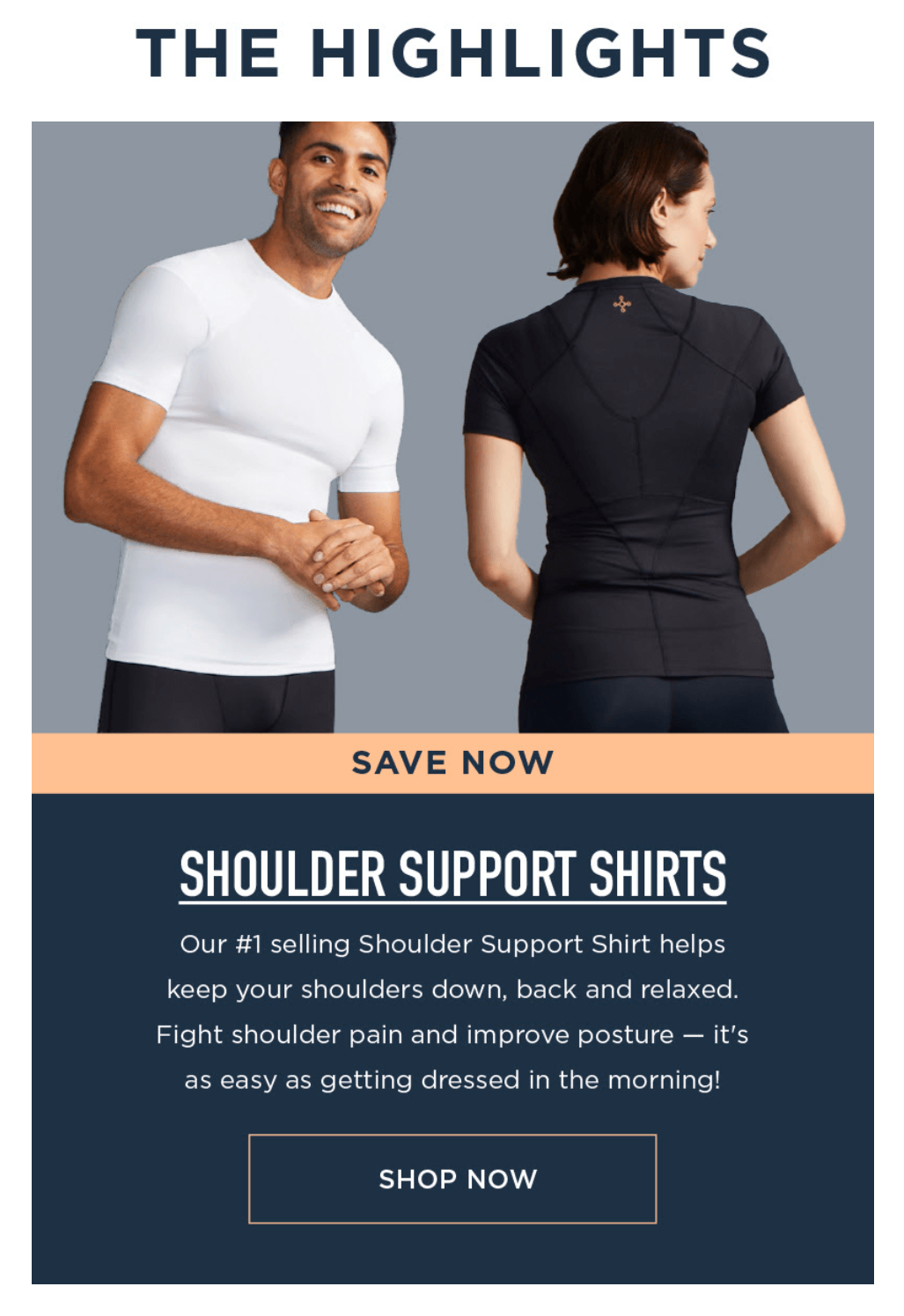
Headline: “SHOULDER SUPPORT SHIRTS”
- It identifies the product and its function.
Product: “Our #1 selling Shoulder Support Shirt helps keep your shoulders down, back and relaxed.”
- It boosts the product’s effectiveness in addressing shoulder issues.
Pain points: “Fight shoulder pain and improve posture”
- The email directly addresses the common pain points of shoulder pain and poor posture, which are likely concerns for the target audience.
Usability: “As easy as getting dressed in the morning!”
- It reassures the reader that using the product is simple and convenient, highlight the ease of use of the solution.
CTA: “SHOP NOW”
- The CTA is strategically placed to follow the description of the product’s benefits, making it easy for the reader to get it.
In a nutshell, this email marketing copy identifies the problem (shoulder pain and poor posture) and offers a straightforward solution (Shoulder Support Shirts).
Combined with supportive visuals and a strong CTA, it makes the email persuasive and likely to drive conversions.
4. Define your product offer
In the previous section, we saw how to address a pain point, in this one we’ll see how to show customers what makes your brand a better choice for them.
The first thing you need is to highlight the unique features and benefits that set it apart from others in the market.
For instance, you can show potential customers that your products or services have better ingredients, superior functionality, or use environmentally friendly practices.
The easiest way to do it is to draw a direct comparison between you and your competitors like Bite did:

Through their email, the brand emphasizes their use of safe, natural ingredients. They also highlight their eco-friendly packaging, offering refillable glass jars that reduce plastic waste.
By outlining these advantages, Bite successfully communicates the superior quality and safety of their product, as well as their commitment to sustainability.
Another interesting element here is how the brand uses color psychology. Green is associated with health, safety, and nature, while red evokes caution and danger.
This makes it easier for customers to understand why Bite is a better choice compared to traditional toothpaste options.
5. Incorporate social proof
Social proof is a powerful marketing tool that involves using the experiences and opinions of others to build trust and credibility with your audience.
Using it in your email marketing strategy can increase the persuasiveness of your messages.
Some of the most popular types of social proof for emails are testimonials, case studies, user reviews, and statistics.
For example, Caudalie uses reviews from buyers to highlight the benefits of their products. Each one is accompanied by a five-star rating and a short quote.

To collect user reviews for your email copywriting strategy, you can follow one or more of these methods:
- Post-purchase emails: Send automated emails requesting reviews after a purchase.
- Incentives: Offer discounts or small rewards for customers who leave a review.
- Surveys: Include review requests in customer satisfaction surveys.
- Social media: Encourage reviews through social media platforms.
- Website pop-ups: Use pop-ups on your website to ask customers for reviews.
Lastly, you can either sprinkle social proof in your promotional campaigns for extra credibility or create a dedicated email campaign to build hype and trust for new products.
6. Keep mobile devices in mind
With more people accessing emails on their mobile devices, ensuring your emails are mobile-friendly will benefit your engagement and conversion rates.
Apart from choosing responsive email designs, here are three steps you need to keep your email copy mobile-friendly:
- Short and to the point: Mobile readers often spend only a few seconds per email, so make every word count.
- Font size and style: Use at least 14 pixels for body text and 22-28 pixels for headings. Stick to clean, sans-serif fonts like Arial, Verdana, or Helvetica, which are easier to read on mobile devices.
- Whitespace: Utilize whitespace to separate sections and make your email content more readable, avoiding a cluttered appearance.
Email platforms like Moosend offer mobile preview features, allowing you to adjust fonts and sizes for an optimal viewing experience on smartphones.
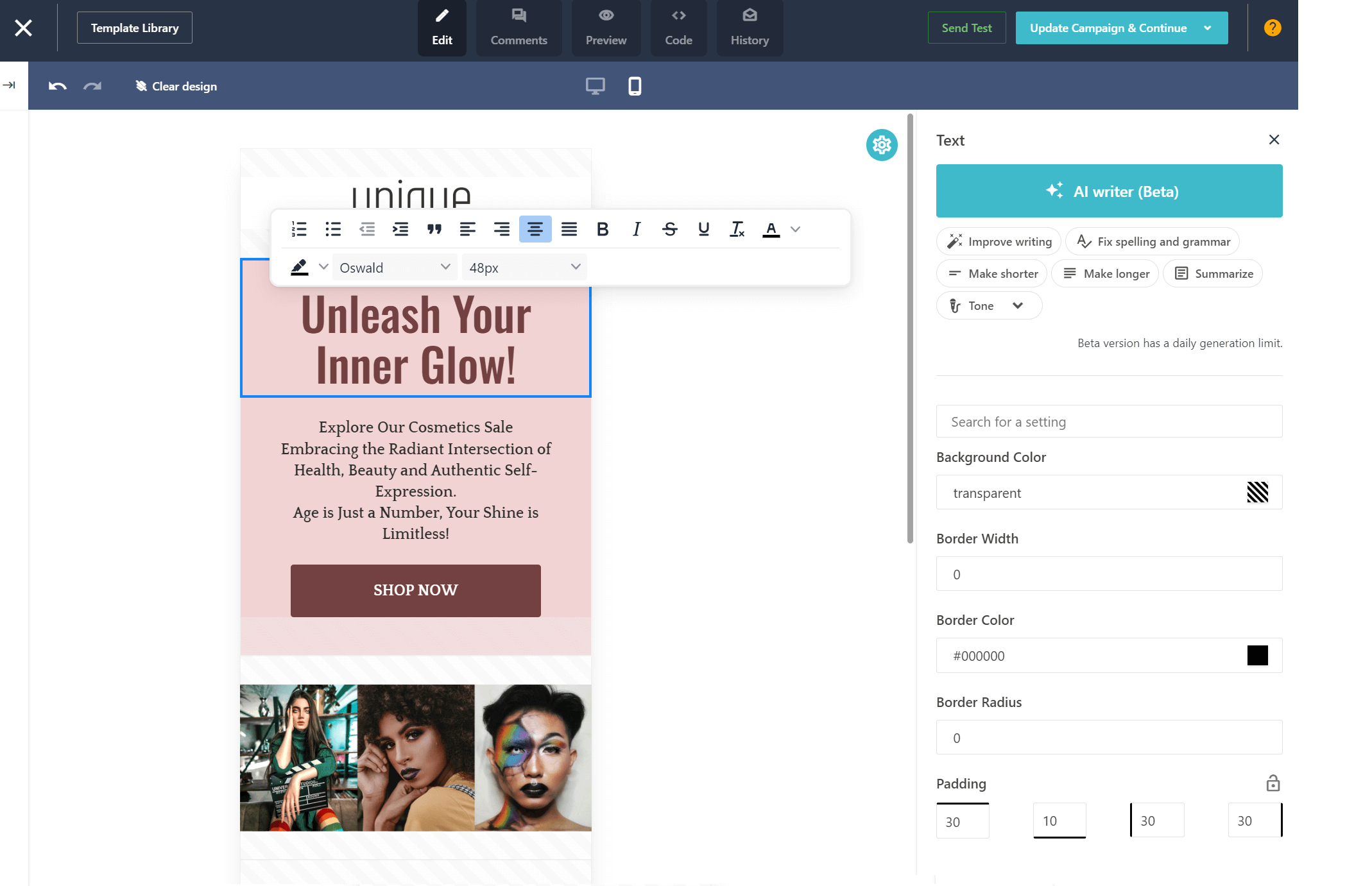
This ensures your emails are highly readable across all devices.
Additionally, you can choose from Moosend’s responsive newsletter templates to focus on crafting compelling email copy without the hassle of designing from scratch.
If you want to customize the above email template and see how the mobile preview works, sign up for a free account.
7. Add storytelling elements
Storytelling is one of the most powerful tools you can use in your email marketing to build an emotional connection with your audience.
By creating a narrative, you make your emails more engaging and memorable. Your stories can take many forms, such as customer testimonials, brand origin stories, or product journeys.
If you’re still skeptical, here’s how storytelling can benefit your emails:
- Humanizes your brand and builds trust with readers.
- Highlights the values and mission of your brand, promoting a deeper sense of purpose and loyalty.
- Makes complex information more accessible and relatable.
In the following example, Cheekbone Beauty showcases the power of storytelling by highlighting the inspiration behind their Liquid Lipstick collection.
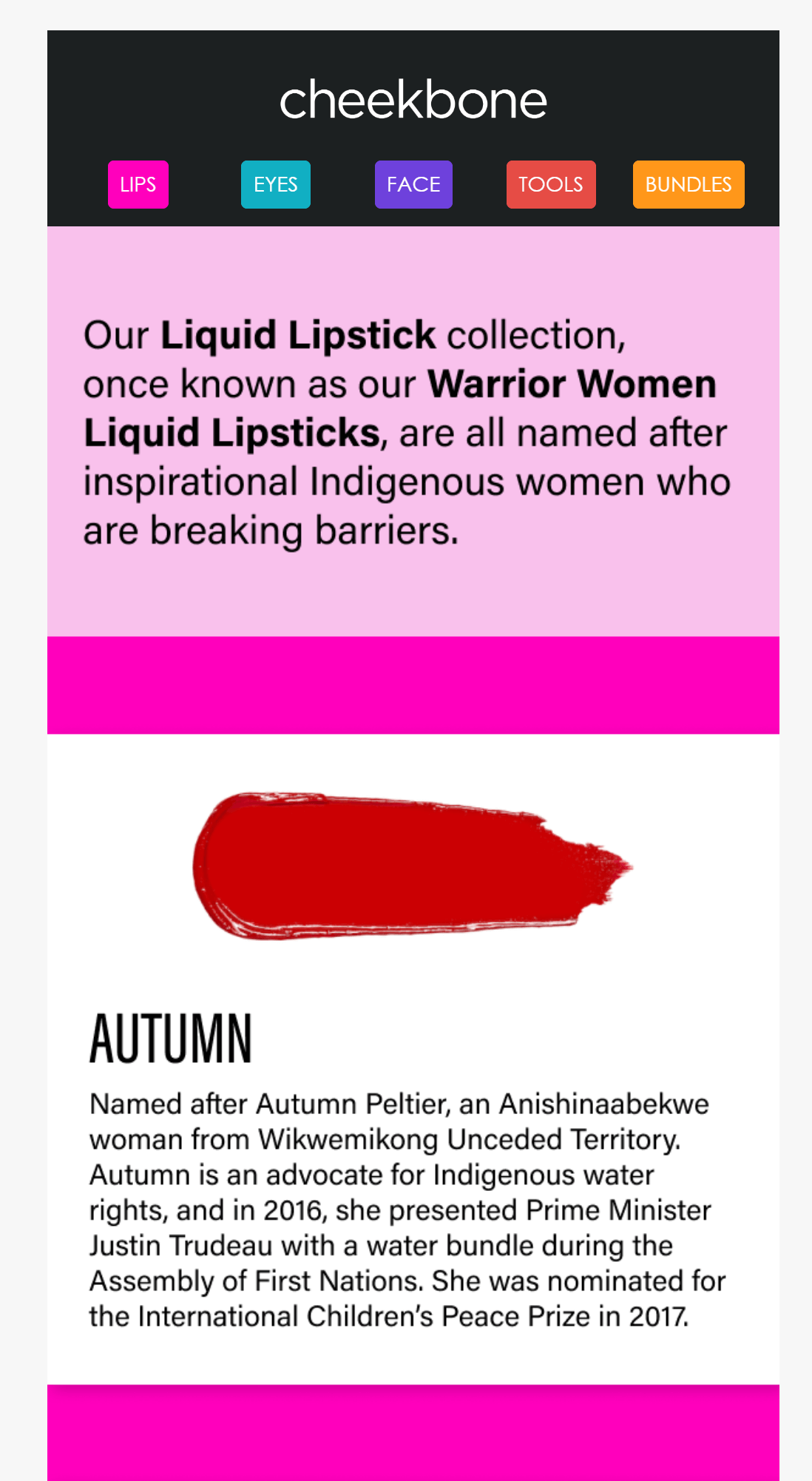
Each lipstick is named after an inspirational indigenous woman, such as Autumn Peltier, an advocate for indigenous water rights.
This approach not only honors these women but also creates a bond with the audience by sharing meaningful stories.
8. Use the 4 “P’s” formula
If you want a more sureproof way to craft your copy, you can follow the 4 P’s email copywriting formula—Promise, Picture, Proof, Push.
This offers a structured approach to creating compelling email copy that resonates with readers and drives action.
Let’s see what each step entails and how Soylent uses the formula in their email campaign.
Promise
Start with a clear and engaging promise that addresses the reader’s needs or desires. This initial promise should be genuine and targeted to avoid sounding spammy and ensure good email deliverability.
Look how Soylent uses their headline and conversational copy to address their customers’ need to fuel their day.
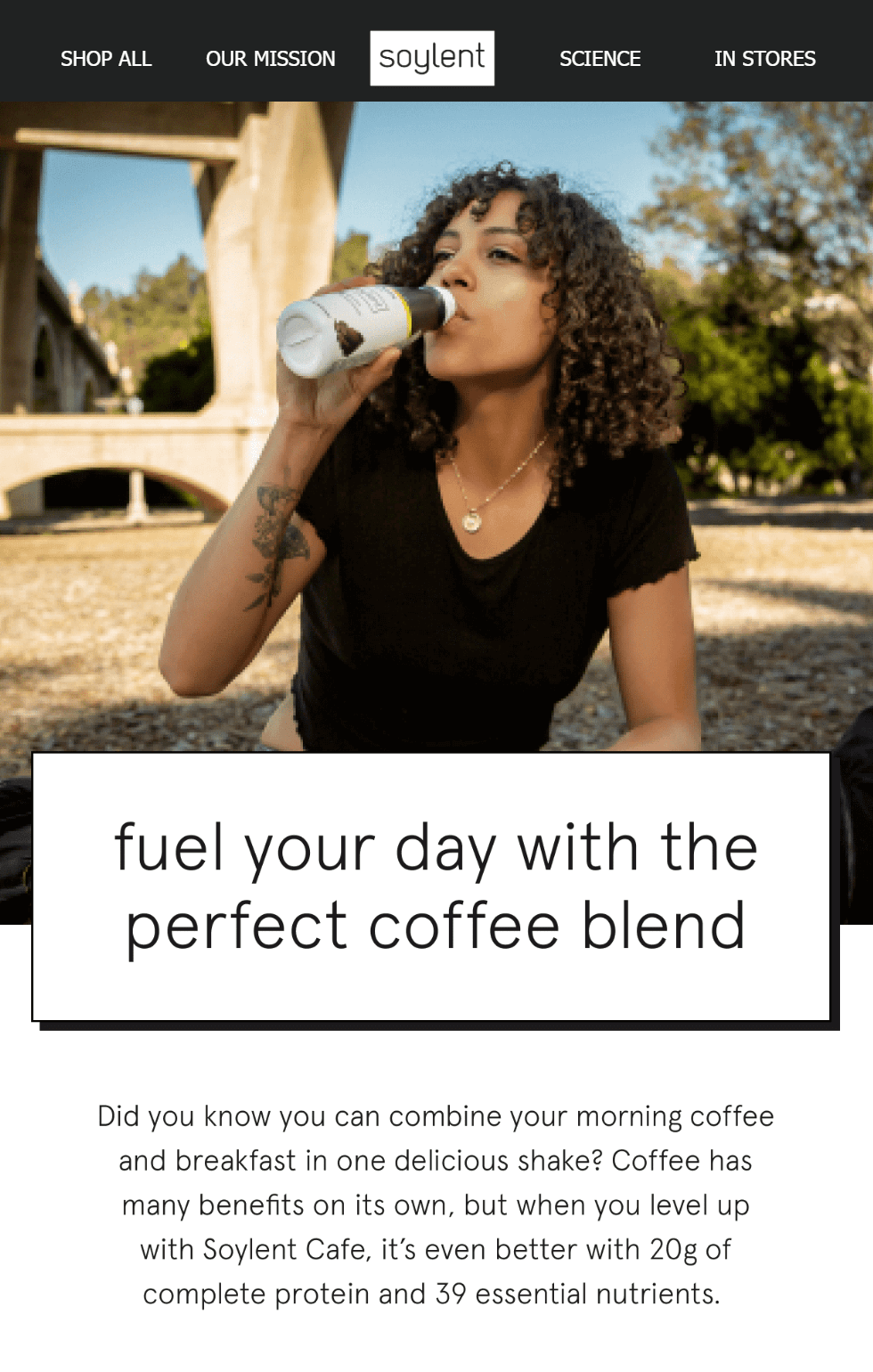
Picture
Next, paint a vivid picture of how your product or service can solve a problem or improve the customer’s life.
This involves detailing the benefits and creating a narrative that allows the reader to visualize the positive outcomes.
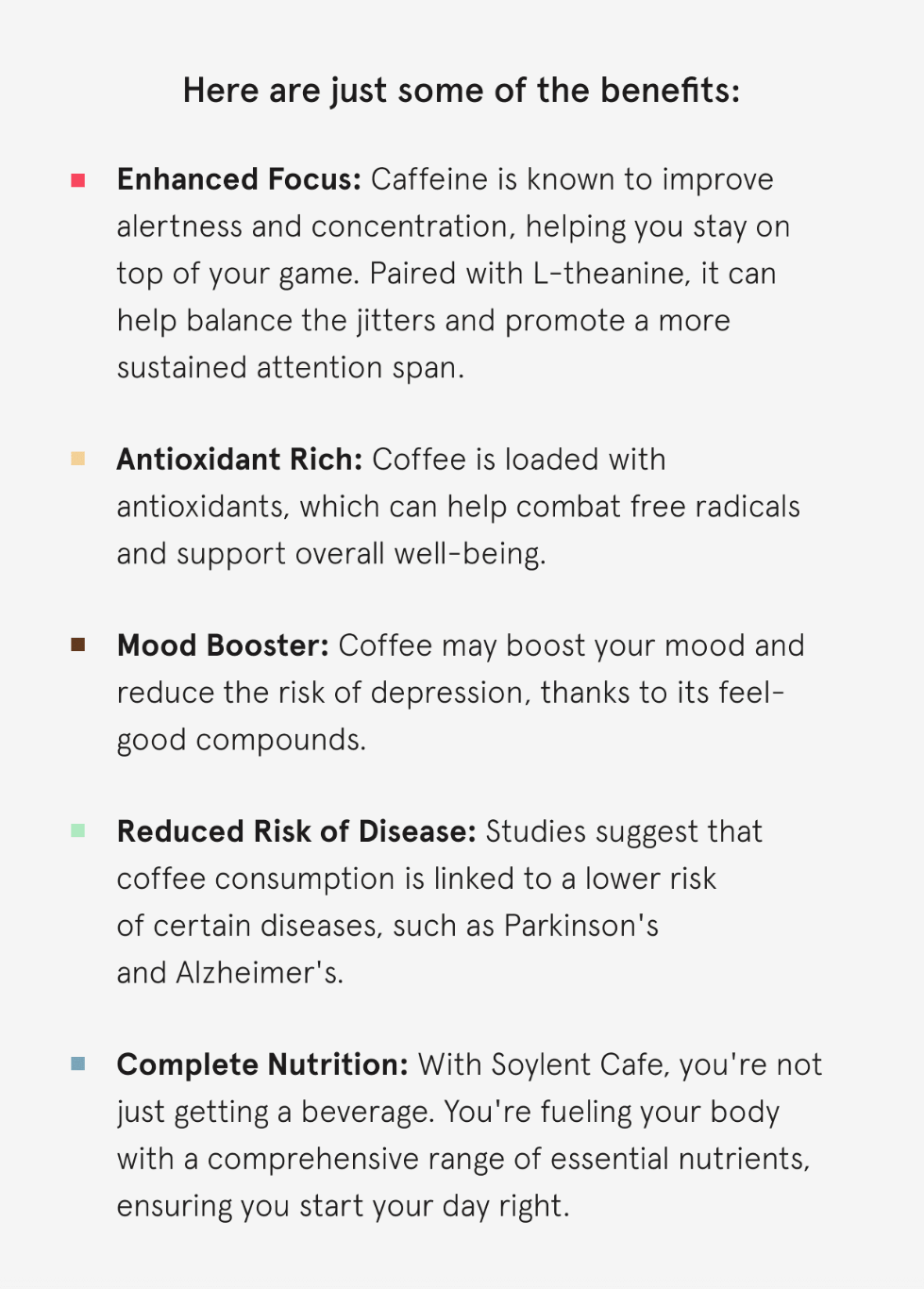
Proof
Incorporate social proof to build credibility and trust. Use testimonials, reviews, or case studies to demonstrate the real-world impact of your product.

Push
Finally, include a clear CTA button that encourages the reader to take the next step. The push should be compelling and direct, such as “Get Started” or “Shop Now,” guiding the reader to act on the promise and the painted picture.
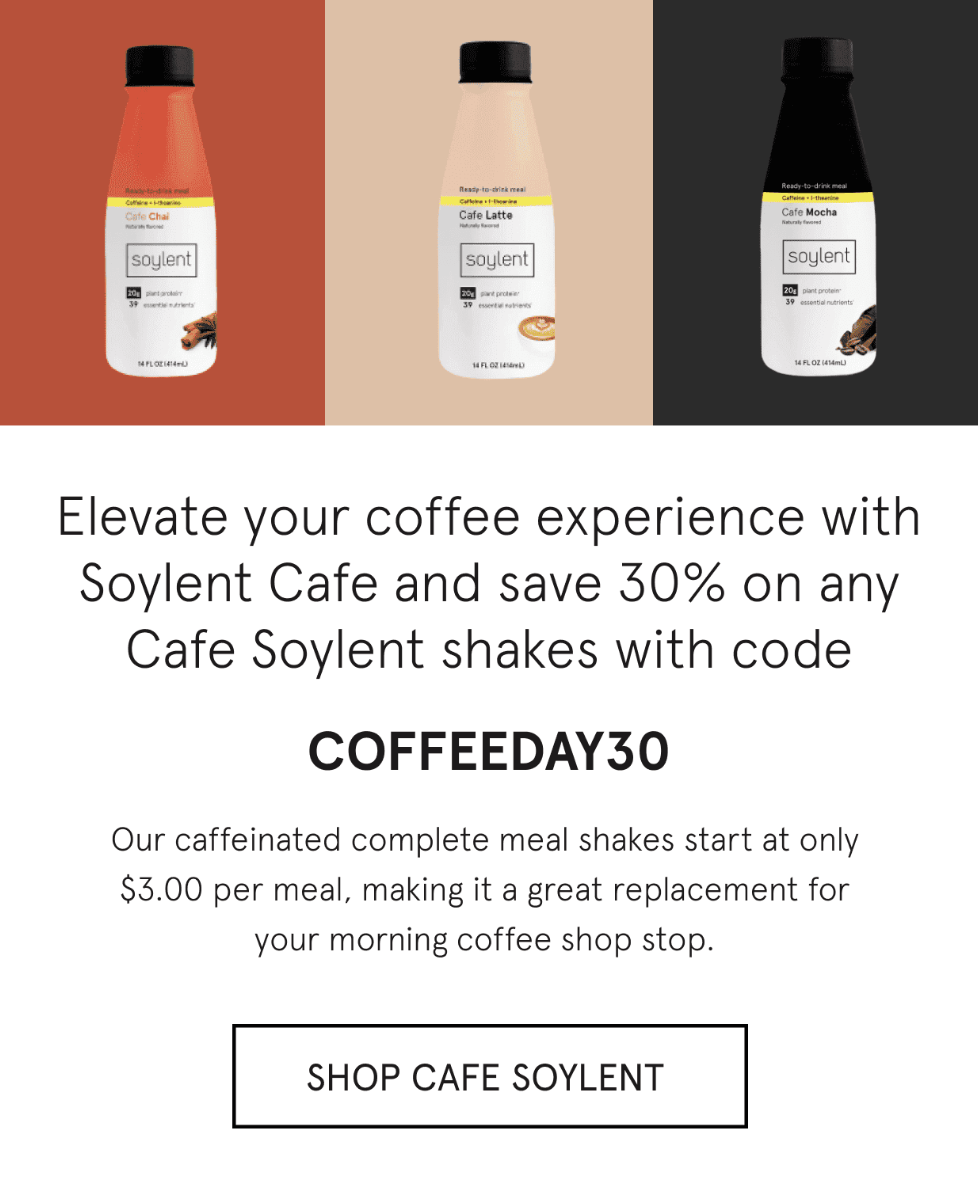
By following the 4 P’s formula, email copywriters and marketers can create structured, engaging, and persuasive sales emails to drive conversions.
9. Align email copywriting with subject lines and CTAS
Continuity from the subject line to the email copy and then back to the website or landing page is more important than you think.
The subject line sets the expectation for the content of the email. When the email copy and the CTA deliver on this promise, it creates a satisfying journey for the recipient. This continuity should extend to the website, ensuring that the visual and textual elements are consistent.
Let’s see an example from Revelry’s email campaign and website.
Subject line: WESTERN GOTHIC
Expectation: The recipient expects to see stylish, gothic-inspired fashion elements with a western twist, likely featuring rustic and elegant designs.
Email design:
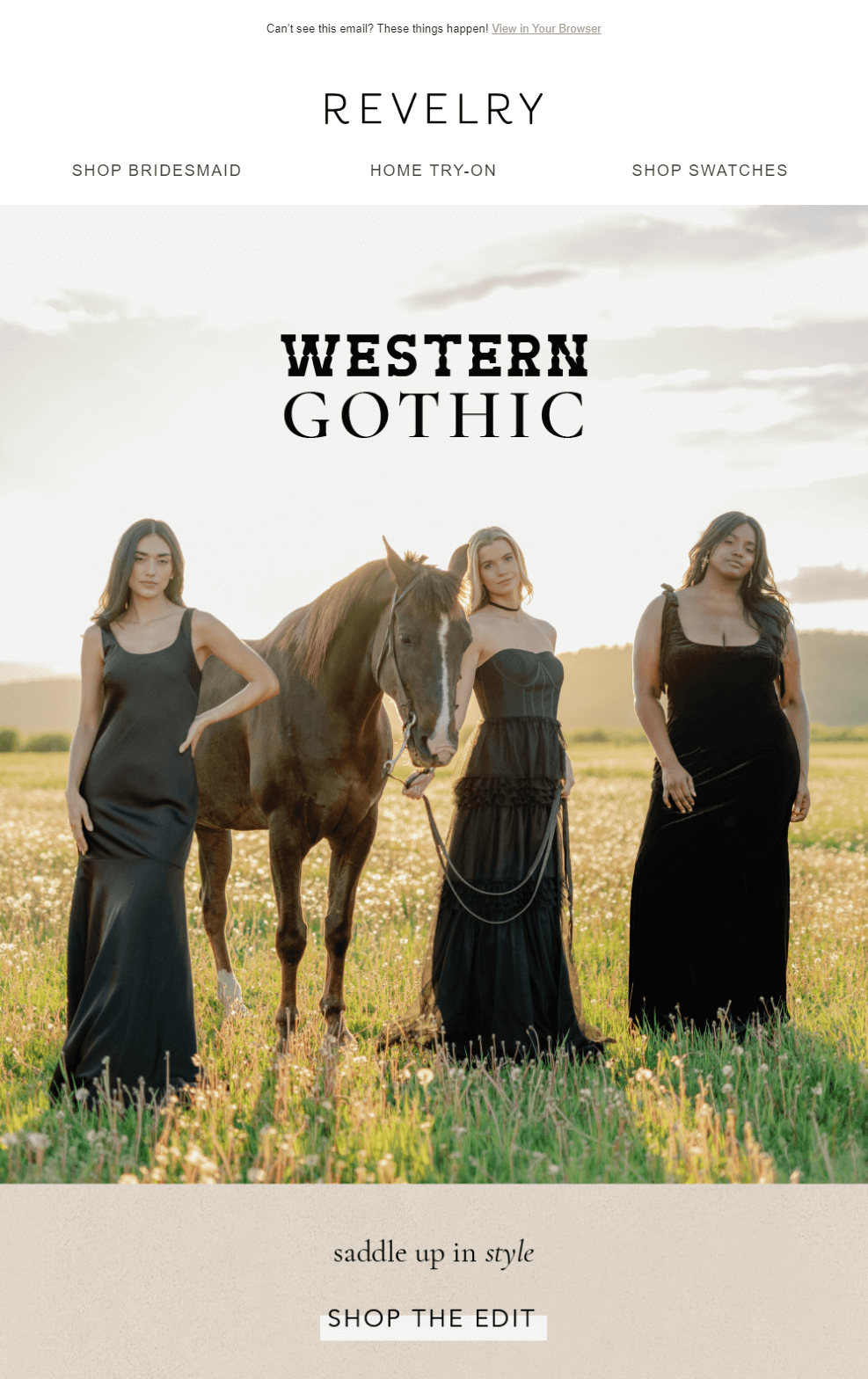
Email copy: The email continues the theme with imagery and text that evokes the “Western Gothic” style, featuring models in gothic-inspired attire against a rustic backdrop. The tagline “saddle up in style” aligns perfectly with the subject line, maintaining the thematic continuity.
CTA: “Shop the Edit” invites the reader to explore the collection, reinforcing the email’s narrative and driving them towards the intended action.
Website: Upon clicking the CTA, the website further elaborates on the “Western Gothic” theme, with matching visuals and product descriptions that align with what the customer has seen in the email.
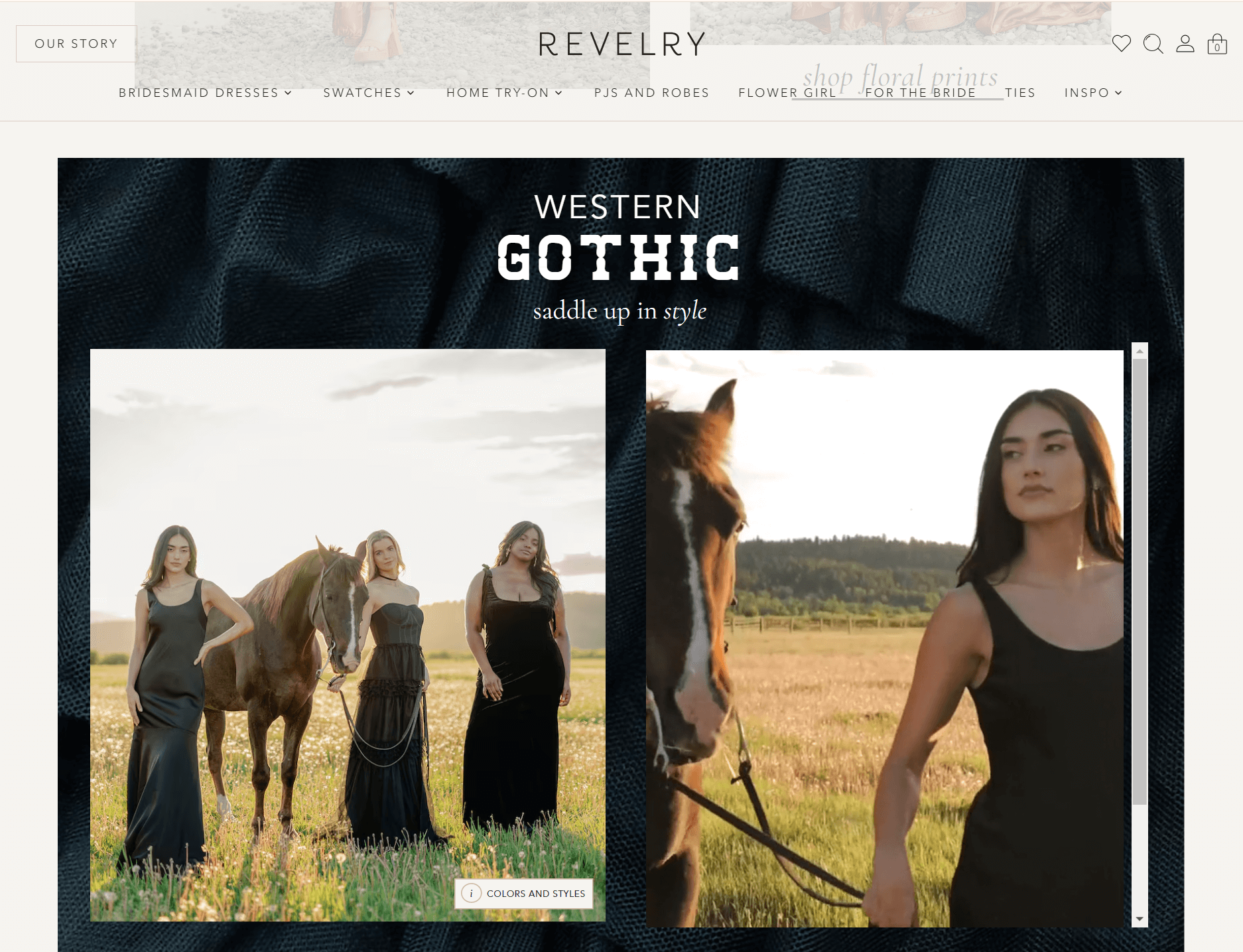
Revelry’s consistency not only enhances the user experience but also increases the likelihood of conversions by reinforcing the message at every step.
10. A/B Test your email copy
If you’ve followed the tips above, you’re well on your way to creating effective email copy. However, to ensure success, you should consider one final step.
Also known as split testing, A/B testing compares two versions of an email to determine which one performs better. By sending version A to one group and version B to another, you can analyze which version yields higher engagement rates, click-through rates, or conversions.
This method provides insights, allowing you to refine various elements of your email, such as subject lines, email lengths, tones, CTAs, personalization techniques, and visuals, to create more compelling and effective campaigns.
Here are the elements you can A/B test:
- Subject lines: Test different lengths, tones, and specific words to see which achieves higher open rates.
- Email length: Experiment with varying lengths to find the optimal balance between information and engagement.
- Language and tone: Compare formal versus informal language and different tones (e.g., friendly, urgent, professional) to see which resonates more with your audience.
- Personalization: Assess the impact of varying levels of personalization, such as using the recipient’s name or personalized product recommendations.
To run an A/B test on your email copy, you can use your email tool to simply create two versions of your email and use the platform’s built-in A/B testing feature to send each version to a segment of your audience.
Moosend will track the performance metrics and help you determine which version is more effective.
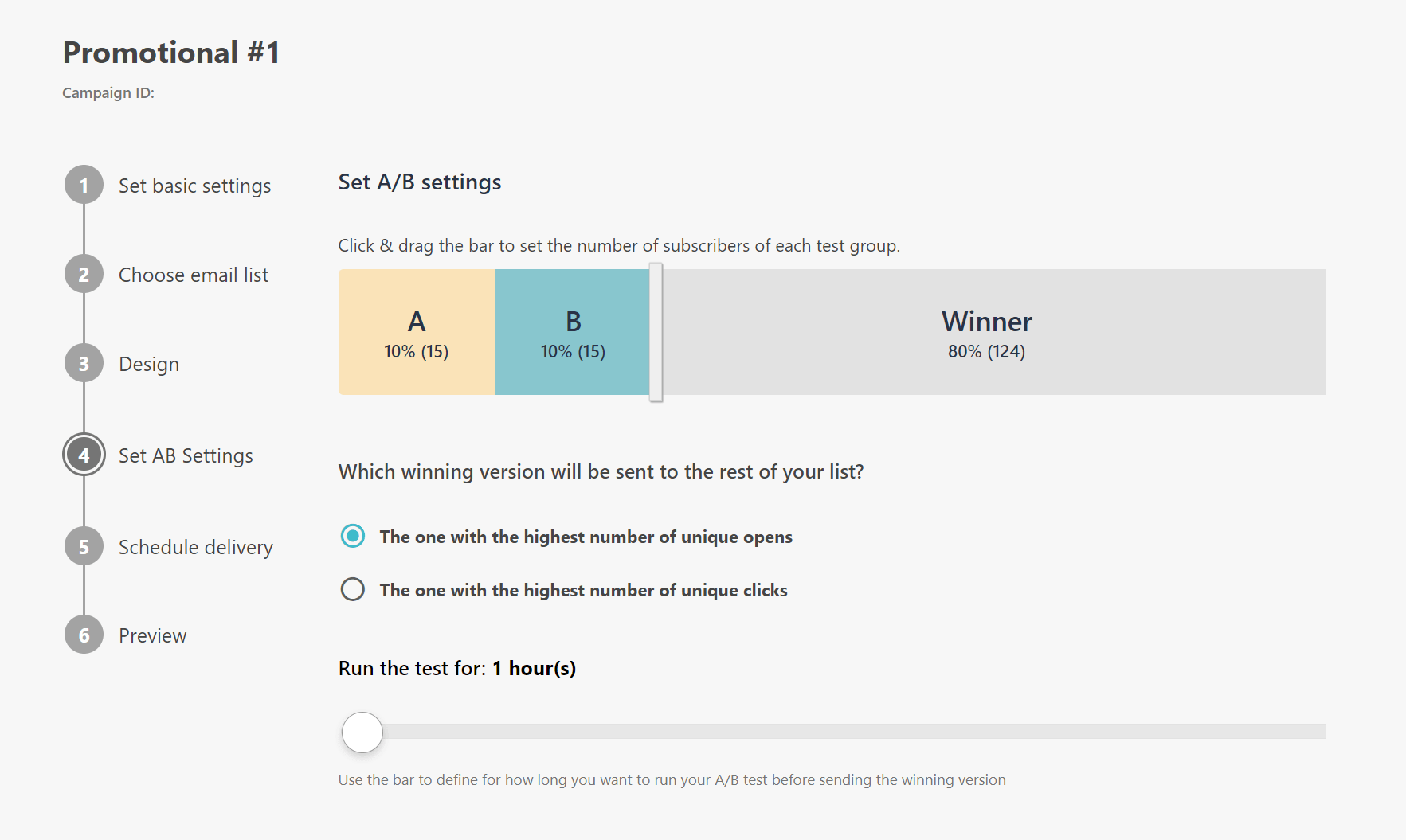
Further reading: Learn everything about email copy testing in our comprehensive A/B Testing guide.
How to Write Email Subject Lines
As mentioned above, crafting an intriguing subject line is necessary to catch your recipient’s attention and encourage them to open your email.
Before we get to the tips, here’s a simple formula you can follow:
Personalization + Action Verb + Benefit + Curiosity/Emotion + Urgency
Now, let’s see how to write them the right way:
Keep them short
One of the best email copywriting strategies for subject lines is to keep things short and to the point.
So, aim for around 30-50 characters to ensure the subject line is fully visible on mobile devices. By looking at our inbox, we found that most subject lines were between 5-10 words.
Examples:
- Shoes for Cabin Fever (Allbirds)
- Where to find us this summer (Jacquemus)
- NEW ALERT! Meet The Loafer Mule. (Rothy’s)
Use action-oriented language
Use action verbs to encourage recipients to open your email. For example, “Buy,” “Save,” “Shop,” “Join,” “Discover,” and “Claim” prompt readers to act quickly.
Additionally, pair them with time-sensitive words/phrases like “Now,” “Today,” “Limited Time,” or “Ends Soon” to create a sense of urgency for better results.
Examples:
- Act now! 40% off ends today! (MeUndies)
- You can save 20% NOW! (Sidemen Clothing)
- discover your wellness wonderland today only! 🗓️ (Bath & Body Works)
Personalize them
Like in your email body copy, add the recipient’s name or relevant details to the subject line to make it more personal.
Here are some ways to effectively place the recipient’s name in the subject line:
- At the beginning: [Name], Unlock Your Exclusive Offer Today!
- In the middle: Exclusive Offer for You, [Name] – Shop Now
- At the end: Special Discount Awaits You, [name]!
Examples:
- Hey Marilia, Back To School Sale is Here! (The Washi Tape Shop)
- Marilia, your promo code is about to expire 🚨 (Endy)
- Selling, Marilia? Find a trusted expert (Realtor)
- 10% off** ends soon, Marilia (Sephora)
Create curiosity
Subject lines that generate curiosity can increase open rates by tapping into the reader’s desire to uncover the hidden details.
Here are some effective phrases to use:
- Guess what we have in store for you
- You’ll never believe what happens next
- We’ve been waiting for [days/months] to announce this …
- X Secrets Revealed!
- Don’t Open ‘Til After [Time/Date]
Examples:
- Guess Who’s Back? (Seafolly)
- Can you guess our new collab? 🤠 🐠 🎈 🚪 💥 (Skinnydip)
- We’ve got a secret 🎀💗🌸 (Cheekbone Beauty)
- You’ll Never Guess What We’re Making Now (Betty Crocker)
- This is what your neighbor is doing this weekend 🤫 (Swiggy)
Highlight the benefits
A benefit-focused subject line directly addresses the reader’s needs or desires, making the email more relevant to them.
To create benefit-focused subject lines:
- Mention the exact advantages the reader will receive.
- Highlight how your email will address a common issue.
- Ensure the benefit is easy to understand and quickly grasped.
- Include numbers or percentages to make the benefit for tangible.
Examples:
- Save up to 50% on Customer Favorites for Pain Relief (Tommie Copper)
- 5 hacks to boost your metabolism 🔥 (Freeletics)
- Get Ready For Summer With 25% Off (Michael Kors)
- Which Hairstyle to Complement Your Wedding Dress? 🤔 👰 (Bellami Hair)
Test your subject lines
Lastly, don’t forget to test your creations to see which ones resonate best with your audience.
You can test various elements such as length, tone, personalization, and urgency to see what captures your readers’ attention.
For example:
Subject line A: “Flash Sale! 50% Off All Items Today Only”
Subject line B: “Hurry! 50% Off Everything – Ends Tonight!”
If you need help crafting the perfect subject line, consider using a subject line tester like Refine. These tools can evaluate how your subject lines will perform and provide valuable suggestions for improvement.
Further reading: You can find more tips by checking our complete email subject line best practices guide.
How to Write Email CTA Copy
Writing CTA copy is easy. However, it can easily get lost in the clutter if you don’t make it stand out.
Let’s see an example from Farfetch:
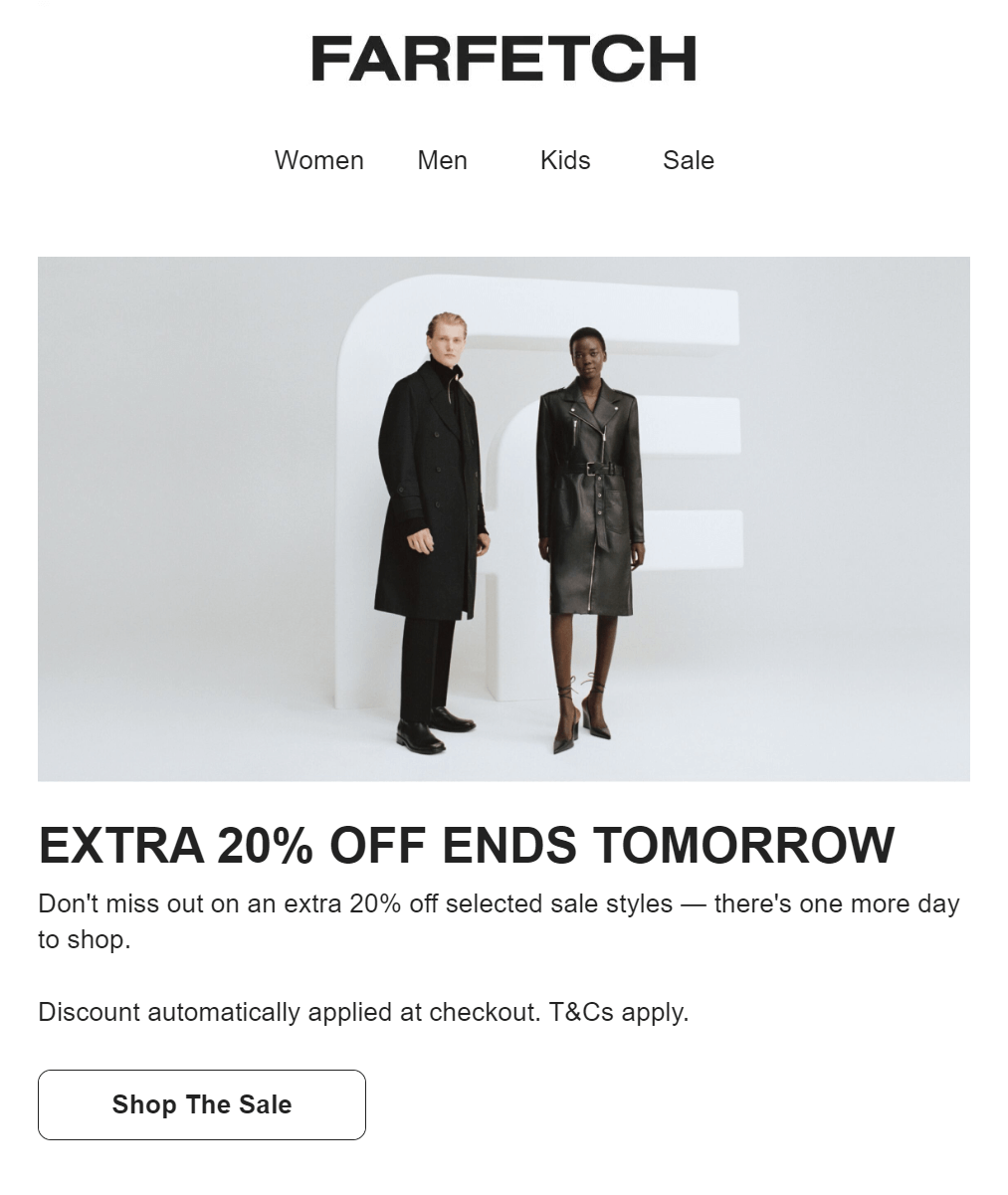
This button is aligned on the left, which makes it easy to miss. Additionally, it doesn’t have a strong visual presence, blending into the background.
Lastly, it’s a bit small, making it less prominent and harder to tap on mobile devices. Let’s see how to avoid that.
CTA Copy
For the best results, use action words like “Get,” “Shop,” “Discover,” or “Join” to make your CTAs compelling.
Phrases such as “Now,” “Today,” or “Limited Time” add a sense of urgency, encouraging immediate action. Lastly, ensure that the action required is clear and obvious to the reader, making it easy for them to understand what to do next.
Examples:
- Learn more here
- Shop [products]
- Try now
- Buy here
- Shop the sale
CTA Placement
Strategically place your CTA within your email to guide the reader naturally towards it.
Here’s how to get the best results:
- Ensure the primary CTA is visible without scrolling.
- Place CTAs at the end of content sections where readers have absorbed the information and are ready to act.
- For longer emails, include duplicate CTAs to capture attention at different stages of engagement.
- Use whitespace to make your them stand out and prevent them from blending into other content.
Here’s an example from Natori’s email:
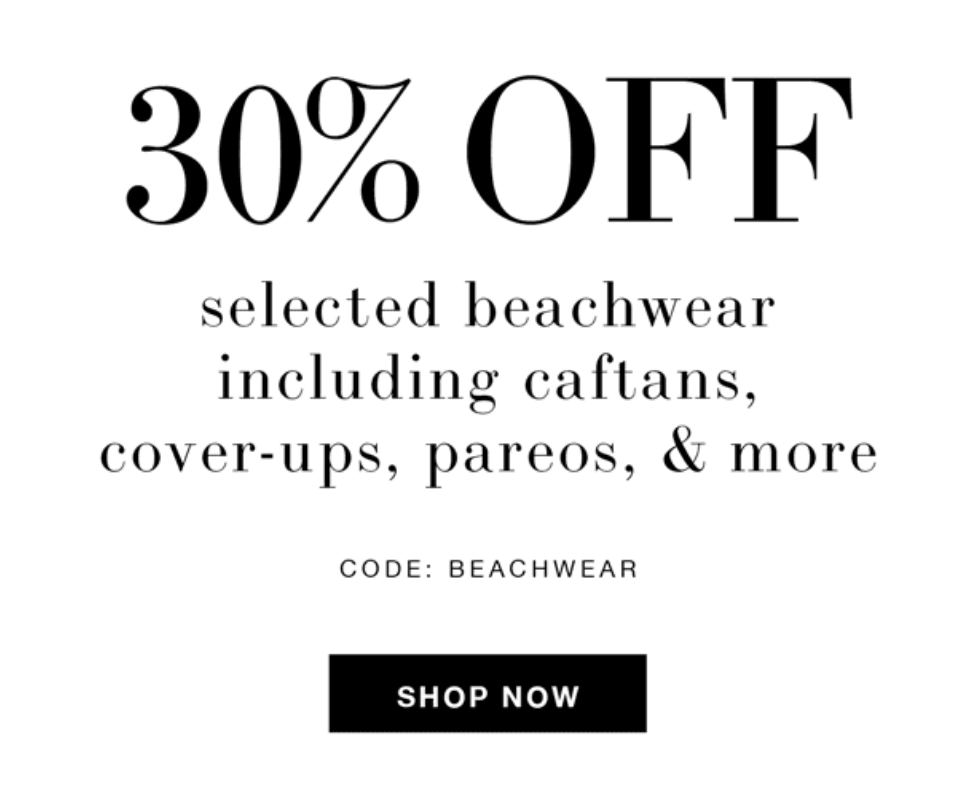
CTA color and size
While Natori’s CTA is great, a splash of color could make it even better. Let’s see how to add the final touches to create the best CTA button:
- Use colors that contrast with the background to draw attention.
- Ensure the font is large enough to be easily read on all devices, typically at least 16 pixels.
- Make the button large enough to be easily clickable, especially on mobile devices, ensuring a minimum CTA button size of 44×44 pixels.
- Maintain a consistent button style throughout your emails to create a seamless reading experience.
Here’s how Masterclass takes advantage of their brand colors to deliver a hard-to-miss CTA:
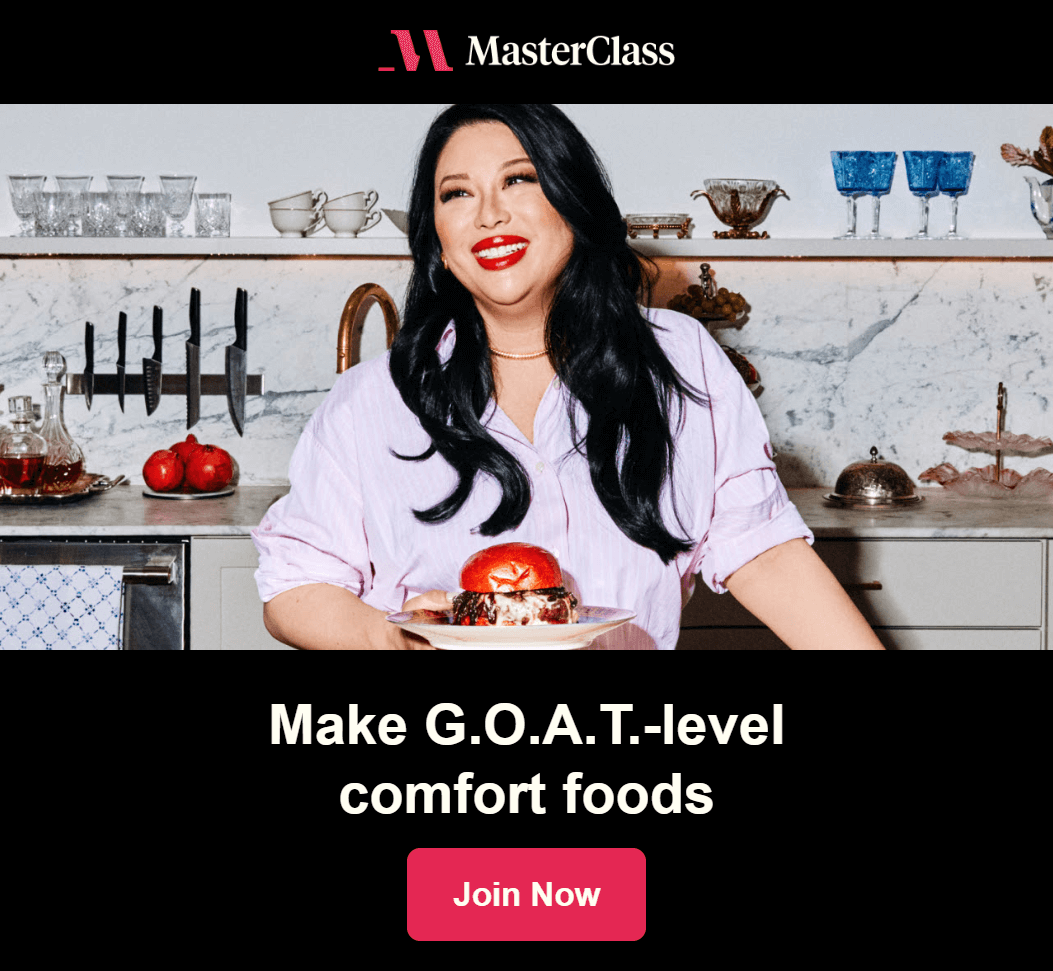
Now that you have mastered the art of great email copywriting, let’s see a few more useful things before you start writing your copy.
Email Templates: Copy & Pre-made Designs
Pre-made templates acan help save time by providing a pre-designed structure that you can customize, ensuring your brand’s look and feel is maintained across all campaigns.
You can create your own copy template or use ChatGPT prompts for quick content generation. Many email platforms offer pre-made design templates.
Also, you can import them from external builders, like Stripo. However, to send your campaigns, you’ll need an email service provider (ESP) like Moosend, which helps manage, send, and track your camapaign performance.
Here are a few pre-made examples you can customize and use in your email marketing strategy.
Welcome email template
You can customize the following welcome email copy and pre-made design to suit your business needs.
Email copy:
Hi [recipient name],
My name is [your name], and I’m the founder of [company name].
I’m so glad that you’ve joined us!
As a small token of my appreciation, I’d like to offer you a [gift/special code/discount].
You can easily access your discount by signing into your account or clicking on the following link: [add link].
Best regards,
[Your name]
Pre-made design:
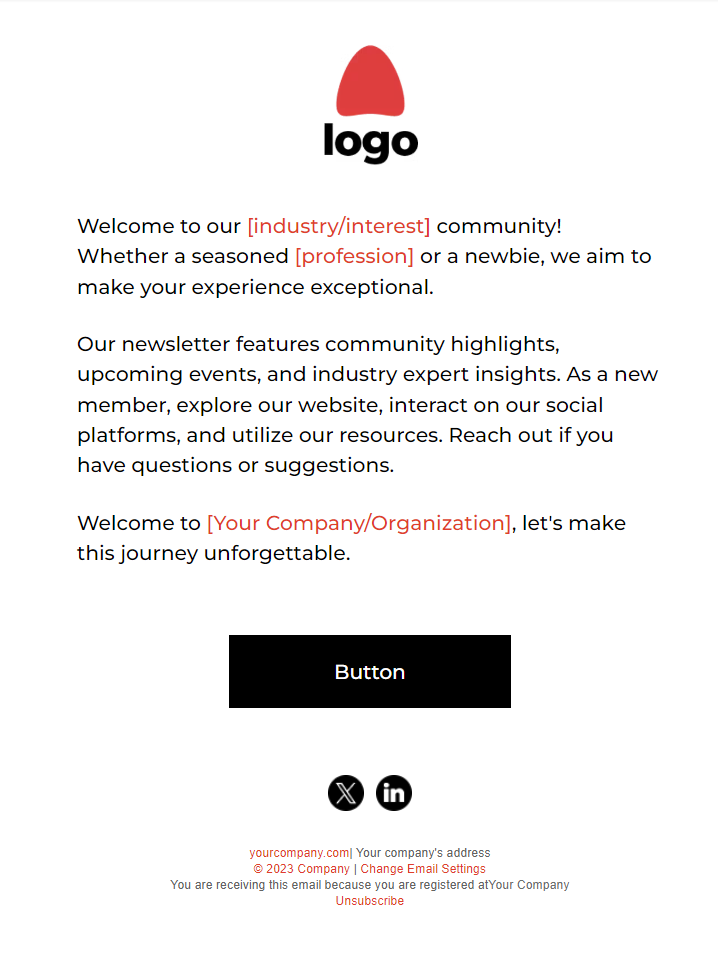
Further reading: Find more templates like the one above in our welcome email templates post.
Abandoned cart email template
Cart abandonment email copy needs to be persuasive and valuable enough to convince your customer to complete their purchase.
Email copy:
Don’t forget about those items in your cart!
Ready to complete your purchase and find your perfect [product]? Click the link below to finish your order and experience the magic of our products in real life.
[CTA Button: Complete My Purchase]
Pre-made design:
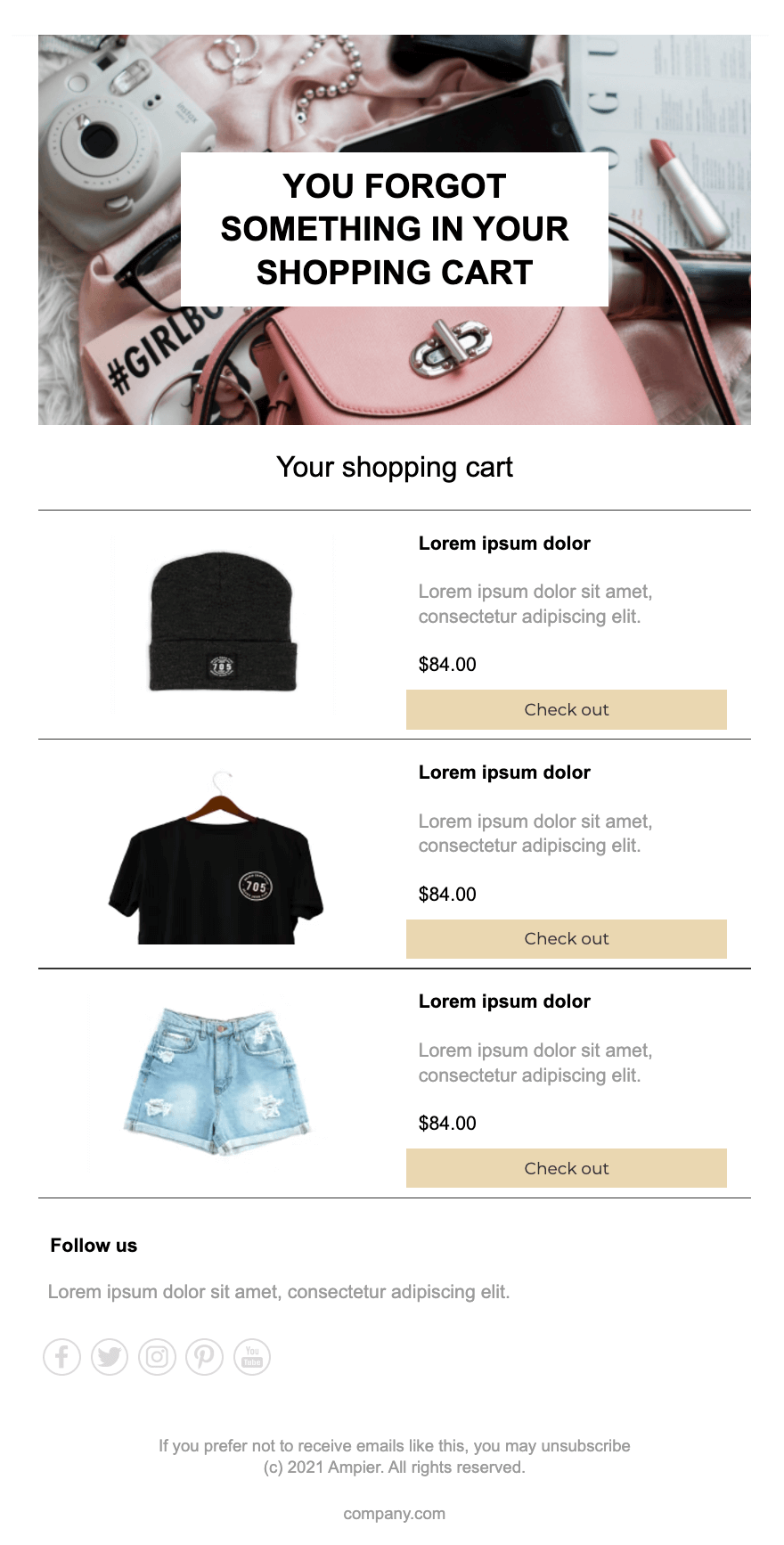
Further reading: Find more pre-made designs in our cart abandonment templates post.
Promotional email template
You can easily customize the copy and template below to promote your products to your audience, highlight benefits, and more.
Email copy:
We are thrilled to introduce our latest addition – the brand-new [Product Name]!
Designed with you in mind, [Product Name] offers [list of features or benefits, e.g., innovative design, unmatched comfort, advanced technology]. Whether you’re [relevant activity or use case], this product is sure to [benefit].
For a limited time, enjoy an exclusive [discount/offer] when you purchase [Product Name]. Don’t miss out on this opportunity to be among the first to experience the difference!
[CTA Button: Shop Now and Save]
Pre-made design:

If you want more templates, visit our library of 110+ email newsletter templates.
Measuring the Performance of Email Copy
Monitoring your performance will let you identify strengths and weaknesses in your email campaigns, allowing you to adjust your strategy to improve engagement, conversion rates, and overall return-on-investment (ROI).
It also provides valuable feedback on how your audience responds to different types of content.
There are specific metrics to track for each email component. Let’s see them below.
Subject lines:
- Open rate: The percentage of recipients who open your email. A high open rate indicates that your subject line is compelling.
- Bounce rate: Shows the emails that could not be delivered. High bounce rates may indicate issues with your email list quality.
- Spam complaints: The number of recipients marking your email as spam. This can reflect poorly crafted subject lines that seem misleading or irrelevant.
Email body:
- Click-through rate (CTR): Recipients who clicked on one or more links in your email. This measures the effectiveness of your email content in driving action.
- Read time: The average time recipients spend reading your email. Longer read times suggest engaging content.
- Forwarding rate: The number of recipients who forward your email to others, indicating highly valuable content.
CTA:
- Conversion rate: The percentage of recipients who completed the desired action (e.g., making a purchase, signing up for a webinar) after clicking on the CTA.
- Click-to-open rate (CTOR): The ratio of unique clicks to unique opens, providing insight into the effectiveness of your CTA within the context of your email content.
Moosend offers comprehensive reporting tools to track and measure email campaign performance through features like a custom reports and real-time analytics.
These tools will help you optimize engagement and conversions by providing detailed feedback on important email metrics.
Email Copywriting Tools to Use
Below, you can find some tools to help you with your email copy creation.
- Grammar and style: Grammarly – Checks for grammar, punctuation, and style issues, ensuring clear and error-free copy.
- Subject line tester: Refine – Analyzes subject lines for readability, sentiment, and open rates, providing scores and improvement suggestions.
- Email copy creation and optimization: Moosend – An email platform with a built-in AI Writer to help you generate engaging email copy on the spot. Apart from that, you can use Moosend’s entire email suite to not only create but also personalize, test, automate, and monitor your campaigns.
- Readability and tone: Hemingway Editor – Highlights complex sentences and common errors to make your copy more readable and engaging.
- Campaign deployment: HubSpot Campaign Assistant – Generates and deploys copy for emails, advertisements, and landing pages, perfect for ensuring consistent messaging for cross-channel campaigns.
Mastering Email Copywriting
Effective copywriting for email marketing is about more than just writing good content—it’s about engaging your audience, addressing their pain points, and creating a seamless journey from the subject line to the call-to-action.
By using personalization, engaging language, and storytelling, you can make your next email more relevant and compelling. Key elements like the subject line, email body, and CTA must be carefully crafted and tested to ensure they resonate with your audience.
Lastly, monitoring performance through metrics such as open rates, click-through rates, and conversion rates will help you refine your approach and improve overall effectiveness.
And if you need a great email tool to support you throughout your email copy journey, you can give Moosend a try for free.
FAQs
Below, you’ll find some common questions and answers about writing copy for email.
1. How do I start email copywriting?
To start email copywriting, begin by understanding your audience and their needs. Learn the basics of crafting compelling subject lines, clear and engaging body text, and strong CTAs. Practice writing emails and use tools like Grammarly and Hemingway Editor to refine your copy.
2. Does email copywriting pay?
Yes, email copywriting can be a great career option. Many businesses and marketers pay well for skilled copywriters who can create effective email campaigns that drive conversions and engagement.
3. Is email copywriting hard to learn?
Email copywriting is not overly hard to learn, but it does require practice and a good understanding of marketing principles. By studying examples, practicing regularly, and using helpful tools, you can become proficient in email copywriting.
4. What is a cold email?
A cold email is a message sent to a potential customer or contact with whom the sender has no prior relationship. Unlike spam, cold emails are personalized and targeted, aiming to establish a connection, generate leads, or initiate a business conversation. The goal is to engage the recipient in a meaningful way, providing value and prompting a response or action.
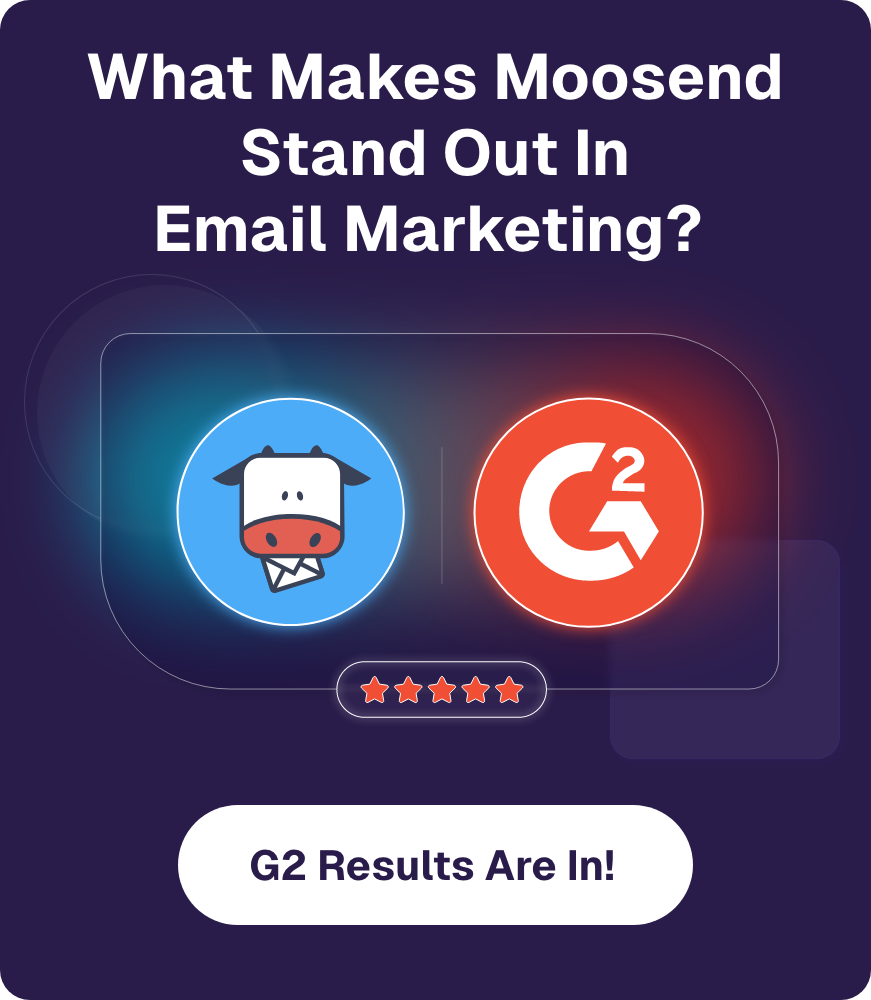



 Published by
Published by

